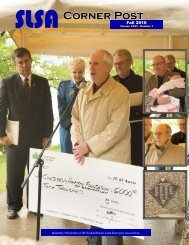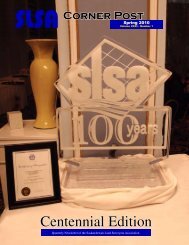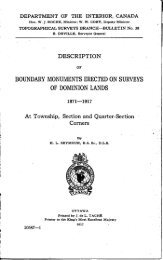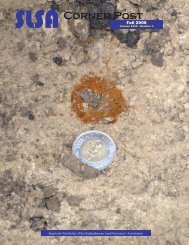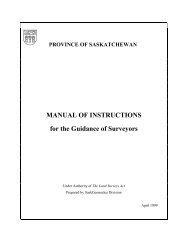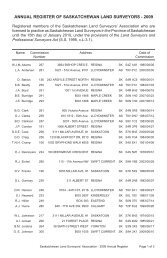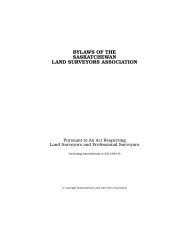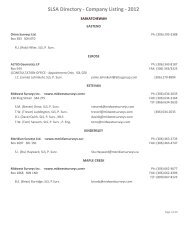SURVEYING FOR PROFITSBy Wayne Newell, C.M.A.Reprinted From “Ontario Professional Surveyor” Volume 49, No. 3, Summer 2006The Continuing Education Committee of the AOLS hostedApril seminars in London, Toronto, Ottawa and Sudburyfor the express purpose of assisting its members to increaseprofits and improve cash flow. This article will highlight thekey strategies discussed at each four-hour course.Two components of profits, risk and return on investmentwould be mandated if I was your financial manager.Risk: the return you get for securing your assets and investmentsto ensure the success of your business. You are entitledto earn some recognition for these risks and that comesin the form of profits. Consider that employees take few orno risks and therefore do not share in this profit component.Return: the return you get for investing your assets in yourbusiness; these come in the form of start-up capital, shareholderloans and re-invested profits. When you invest assetsin other businesses you expect a good rate of return - ensureyou make a good return on your invested assets in yourfirm.When bidding new work, owners are prone to let their entrepreneurialemotions dictate their bid prices. While I understandthis rationale, I suggest that all identifiable costsbe included in each estimate and then a “BUY” amount bedetermined to set the final price. With this identification theactual results of the job can be compared to the original estimatedcosts, a necessary tool to discover the reasons behindgood and poor results on a job. Your price must include ALLcosts of the job. Simply defined, they are costs that would notbe incurred if you were not awarded the job.One of the problems in any business is labour productivity.We certainly cannot arbitrarily reduce the size of our workforceby laying off employees but we can implement proceduresand controls that increase productivity in 15-minutesegments. Look for 15-minute time savers each day. Theresults will be significant. You have no doubt heard of Murphy’sLaw but have you heard of Parkinson’s Law, “Workexpands to fill the time available.”I particularly enjoy discussing negotiation techniques withthe key strategy being to “flinch” when prices are offered toyou even though they may meet your planned prices. Flinchingvery subtly sends the message that you wish to enter intonegotiations. Remember, that by negotiating with a given offer,you can only improve your position.The subject of contract extras must be raised with a PreEngagementUnderstanding. Prior to signing a new contract, apre-job meeting should be held with the owner and professionalsurveyor. You should assure them that your firm willfully abide by the contractual agreement, but that it is anabsolute necessity that all parties to the contract completelyagree upon how changes and additions to the work will behandled. Gross profit is defined as revenue earned from aproject less the direct costs incurred to complete that project.It is prior to any overhead expenses such as managementsalaries, professional fees, marketing, utilities, etc.Determining your gross profit factorRevenue 3,000 4,000 5,000Cost of sales 2,000 3,000 4,000Gross margin 1,000 1,000 1,000% 33% 25% 20%Factor 3 4 5Consider that your company determines it needs to hire aclerical assistant for your office at an annual cost of $24,000.At a gross profit factor of 3, you must increase your annualrevenues by $72,000 to maintain your current level of profits.You now have the opportunity to reinforce your decisionwith an additional factor - the need to increase revenue by$72,000. Will the addition of this assistant lead to the salesrequired to cover the additional cost?GrossmarginFactorNew ExpenseRevenueIncreaseMonthlyRevenueIncreaseAnnually33% 3 2,000 6,000 72,00025% 4 2,000 8,000 96,00020% 5 2,000 10,000 120,00010% 10 2,000 20,000 240,000I suggest you take the time to review your administrationexpenses from your last financial statement. Apply your GPfactor to these expenses for a realization of what revenues areneeded to cover these expenses. Such an exercise allows youto re-examine the need for all your expenses. When facedwith the monthly or annual revenues necessary to pay theseexpenses, you may have good cause to review and perhapsreduce some of them.286 SLSA Corner Post <strong>Fall</strong> 2006
Expense Annual Factor RevenueRequiredFactor RevenueRequiredSalaries 50,000 3 150,000 4 200,000Phone 2,000 3 6,000 4 8,000Office 2,000 3 6,000 4 8,000Auto lease 6,000 3 18,000 4 24,000Insurance 4,000 3 12,000 4 16,000Interest 2,000 3 6,000 4 8,000Prof. fees 2,000 3 6,000 4 8,000Rent 9,000 3 27,000 4 36,000Depreciation 2,000 3 6,000 4 8,00079,000 237,000 316,000With three numbers you can develop your profit plan andrevenue requirements for a year. Let’s make a basic assumption- you could get a stress free, 40 hour a week job witha land surveying firm in your area with annual salary andperks around $70,000. However, for various reasons - independence,community standing, and desire to earn more -you are determined to own your own firm.Forecasting profits and revenueAnnual overhead expenses 100,000 100,000Profit goal 50,000 50,000150,000 150,000Gross profit factor 3 4Revenue required 450,000 600,000When your annual overhead is $100,000 and your profit planis to make $50,000 AFTER your salary, your annual revenueis quickly identified.Discussions with many of the participants convinced me thatyour prices are too low - and most recognized that fact. Reluctanceto charge a price that includes all costs plus a contributionto overhead costs plus a planned profit is mandatoryto stay in business. If you charge only enough to make areasonable salary your path is clear - get a job and eliminateyour risk, your headaches and your sleepless nights.I demonstrated that a 10% across the board increase in priceswith a 40% decrease in revenue would leave you a bit betteroff. So why not raise prices, reduce your workload and maintainyour same profits? Consider the bottom line increases ifyou don’t lose 40% of your business - it will be significant.On every $100,000 you improve profitability by $10,000!Are you willing to cut your prices to increase your volumeand thus earn more profit? Charts showed an extraordinarycase where you double your volume, reduce your price by50% and actually lose money. Price cutting does not work.Everyone learned the basic procedures required to develop a4-week cash flow forecast, the potential problems that couldbe revealed and the decisions to be made to avert those problems.The courses concluded with my thoughts on how I wouldmanage your business.. . . I would ensure the following key strategies were implementedand used in order to maintain and improve your profits:an aggressive revenue drive, timely billings, assertive accountcollections, determined negotiating skills, timely costreports, cash flow forecasts, practical internal controls, andpostcompletion job reviews.. . . I would look at your billable hours and billing rates toensure that they were adequate to achieve your profit expectations.. . . I would ensure that all billings were prepared and deliveredin a timely manner - after I had reviewed each one todetermine if all costs were included. When I reviewed thecontracts for extras I would ask, “Is it free to me?” If not, itmust be billed.. . . I would ensure billings are monitored for timely paymentsand would aggressively pursue all accounts past theirdue dates. Emphasis would be placed on Unbilled Revenue.. . . I would ensure that we negotiated all major material andequipment purchases for best price and delivery dates. Negotiatingskills take time and practice but I am certain thatjob profits will improve by employing the Flinch, Refer to aHigher Authority, Split the Difference, Low Ball, Show noEmotion and Know Strengths and Weaknesses techniques.. . . I would insist on employees recording their daily time bycost code and then prepare timely, effective cost reports thatwould guide me to corrective action prior to the job completion.. . . I would forecast weekly cash flows for the next eightweeks and the following three months, since cash flows arecritical to every business. These forecasts will serve as usefulguides to cash shortfalls and surpluses.. . . I would implement internal controls to safeguard yourassets with the most notable being: signing all cheques afterviewing supporting documentation, reviewing all billings,open and view all bank statements and review gross profitsand cash flows on bids prior to their submission.. . . I would conduct post-mortems on completed jobs todiscover what went wrong, what caused the problems andhow the company will avoid those issues during the next job.If a job went well, we would use this time to identify whatwent right and ways to recreate that experience on the nextproject.. . . I would accept that my primary responsibility as yourmanager is to earn a profit. By following these strategies, Iwill meet that responsibility.Wayne Newell, C.M.A. has held senior fi nancial roles with small to mediumsized companies during his 30-year management career. He can be reachedby email at: waynenewell@eastlink.ca. He will be setting up a special page forprofessional surveyors on the following website: www.contractingworkshop.com.SLSA Corner Post <strong>Fall</strong> 2006 287




